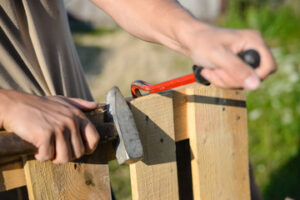Choosing the right Fence Company is an important decision that will affect your satisfaction and the value of your investment. Using discerning judgment in your interactions with potential firms will help you make the proper determination.

Ask for referrals from trusted sources and consult online reviews. Look for a friendly, knowledgeable staff that delivers an enjoyable experience.
When choosing a fence company, it’s essential to find one that offers quality workmanship. This will ensure that the finished product matches or exceeds your expectations. Look for reviews from past customers and ask about their satisfaction levels. You can also check if they are licensed and insured, which is a good indication that they have the proper skills to complete the job. You should also read their contract carefully before hiring them to avoid any surprises down the road.
A good fencing company will have an office and a warehouse to store their materials. This way, they can work fast and meet deadlines. They should also have insurance coverage in case anything goes wrong on the project site. Some companies also have special insurance coverage for natural disasters, such as flood or tornado coverage. This is important to consider if you live in an area that’s prone to these events.
It’s best to choose a fence company that has a lot of experience in the industry. They’ll know how to build a quality fence and will be able to advise you on the type of fence that would be right for your property. In addition, they will be able to answer any questions you may have about the process and how long it will take to get your fence installed.
You should look for a company that has a great reputation in the community and a solid business model. This will give you peace of mind knowing that your new fence is in good hands. You can find this information by searching online for local companies and reading customer reviews. A reputable fence company should be transparent about their pricing and provide you with a clear estimate of what the entire project will cost, including cleanup and removal of the old fence.
A good fencing company should offer quality products and excellent service at affordable prices. This will make them stand out from the competition and attract more clients. They’ll also have a large portfolio of past projects to show off their skills and experience.
Competitive Pricing
If you’re a fencing contractor, you can keep clients coming in by advertising competitive pricing. To find out what your hourly overhead is, add up the cost of all monthly expenses and divide it by the number of hours you work each month (let’s say 16). Now, figure out how much you need to charge per job to cover all overhead costs and still earn a profit.
A reputable fence company is transparent and upfront about their pricing. If you see a low price, look closely at the company’s details to make sure they offer quality products and services for the price. It’s also a good idea to check the fence company’s customer reviews to see how they treat their customers.
To promote your business, consider sharing photos of completed jobs on social media and printing business cards and vehicle wraps that display your fencing services logo. You can also create a website that allows potential customers to view photos of different fence materials and book services online. Finally, invest in digital marketing by creating listings on Google Local Services and search ads to reach customers searching for a fencing contractor near them. It’s a good idea to get a limited liability corporation established, too, in case legal issues or damages occur. This will protect your personal assets from any lawsuits filed against you by employees, customers, or vendors.
Free Estimates
If you want to start a fencing company, there are several things you should know. First, you will need a business plan to identify your customers and determine how you will stand out from competitors. This will also be essential if you need to secure startup capital from investors. Having a business plan will help you get started by showing potential lenders that your idea is sound.
Before you can begin building a fence, you will need to have a good understanding of the local land use regulations and other laws governing construction. This will prevent you from accidentally building a fence that is too close to your property line or encroaching on someone else’s property. Moreover, it will ensure that your fence is constructed properly so that it will be safe and durable for years to come.
In addition to these regulatory requirements, you will also need to make sure that your fence company has liability insurance and worker’s compensation coverage. This will protect you and your employees in the event of an accident or injury. Additionally, you should consider getting flood and tornado insurance, which may be necessary depending on where your clients live.
Some areas require that you obtain a permit before installing a fence, so check with your fence contractor to see if they will handle this process or if it is your responsibility. In some cases, you may also need to contact the local utility marking service to have your yard marked so that the builders do not hit any underground pipes or lines.
Fences are not only a great way to add privacy to your home, but they can also lower street and freeway noise levels. This is especially important if you live near a highway or busy street. Fences can reduce the amount of noise by as much as 6 to 10 decibels.
When you’re ready to purchase a fence for your home, find a fencing company that offers free estimates on their services. This will allow you to make an informed decision and save money at the same time.
Professional Installation
When it comes to installing a new fence, you want to hire a reputable contractor. A professional will ensure that the fence is installed correctly and is in compliance with local codes. They will also handle any permit applications that may be necessary. Lastly, they will work with the homeowner to determine what materials are best for their property and vision.
The first step in finding a qualified fencing contractor is to do some research. Start by asking family and friends for recommendations and looking online. Once you have a few options, call them and ask about rates, qualifications and experience. Some companies offer a free estimate, while others charge for their services. Some also have a customer service department to answer any questions.
Most states require fencing contractors to be licensed in order to operate their business. To check licensing requirements in your state, contact your local government or the Secretary of State’s office. Depending on your state’s laws, you may be required to register your business name, obtain a permit, and get insurance. In addition, you may be required to attend a training program or complete a class before you can work in the industry.
Fence installation is a complex process that can vary depending on the type of fence you choose and the construction site. For example, some fences are built from scratch on-site, while others can be premade and shipped to the jobsite. The time it takes to install a fence will also depend on the material used.
After you have chosen a fencing contractor, it is important to follow up with local references. Any reputable fencing contractor will be happy to provide you with names and phone numbers of past clients. If possible, try to visit some of their jobsites to see the finished products in person.
A new fence can enhance your home’s curb appeal and increase its resale value. However, it requires periodic maintenance to keep it looking nice and functioning properly. It is recommended to sand and stain or seal your fence every three to five years. This will help protect it from moisture and sun damage, and keep it from becoming warped or rotting.
